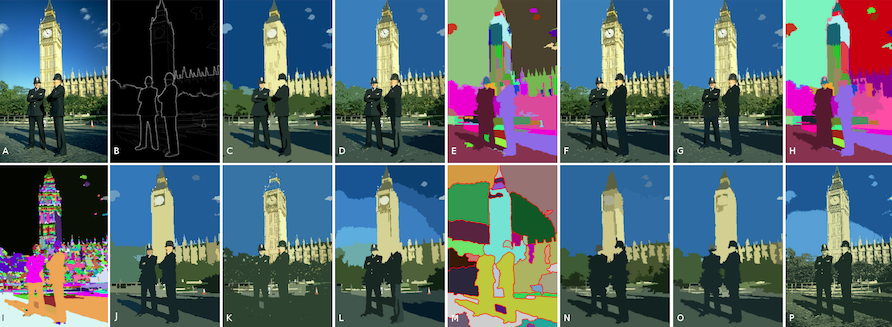Can the Use of nonlinear Color Metrics systematically improve Segmentation?
DOI:
https://doi.org/10.22456/2175-2745.79885Keywords:
Image Segmentation, Nonlinear Color Metrics, Polynomial Mahalanobis Distance, Split and Merge, Variational Methods, Graph-Based Segmentation.Abstract
Image segmentation is a procedure where an image is split into its constituent parts, according to some criterion. In the literature, there are different well-known approaches for segmentation, such as clustering, thresholding, graph theory and region growing. Such approaches, additionally, can be combined with color distance metrics, playing an important role for color similarity computation. Aiming to investigate general approaches able to enhance the performance of segmentation methods, this work presents an empirical study of the effect of a nonlinear color metric on segmentation procedures. For this purpose, three algorithms were chosen: Mumford-Shah, Color Structure Code and Felzenszwalb and Huttenlocher Segmentation. The color similarity metric employed by these algorithms (L2-norm) was replaced by the Polynomial Mahalanobis Distance. This metric is an extension of the statistical Mahalanobis Distance used to measure the distance between coordinates and distribution centers. An evaluation based upon automated comparison of segmentation results against ground truths from the Berkeley Dataset was performed. All three segmentation approaches were compared to their traditional implementations, against each other and also to a large set of other segmentation methods. The statistical analysis performed has indicated a systematic improvement of segmentation results for all three segmentation approaches when the nonlinear metric was employed.Downloads
References
UDUPA, J. K. et al. A framework for evaluating image segmentation algorithms. In: Computerized Medical Imaging and Graphics. New York, Usa: Pergamon Press, 2006. v. 30.
SOBIERANSKI, A. C. et al. Learning a color distance metric for region-based image segmentation. Pattern Recognit. Lett, v. 30, n. 16, p. 1496–1506, 2009.
SOBIERANSKI, A. et al. Learning a nonlinear
color distance metric for the identificationof skin immunohistochemical staining. In: Computer-Based Medical Systems, 2009. CBMS 2009. 22nd IEEE InternationalSymposium on. Albuquerque, USA: IEEE, 2009. v. 22.
SOBIERANSKI, A. C.; COMUNELLO, E.; WANGENHEIM, A. von. Learning a nonlinear distance metric for supervised region-merging image segmentation. Comput. Vis. Image Underst., v. 115, n. 2, p. 127–139, 2011.
CARVALHO, L. E. et al. Hybrid color segmentation method using a customized nonlinear similarity function. Int. J. Image Graph., v. 14, n. 01n02, p. 1–13, 2014.
CARVALHO, L. E. et al. Improving graph-based image segmentation using nonlinear color similarity metrics. Int. J. Image Graph., v. 15, n. 04, p. 361–369, 2015.
REHRMANN, V.; PRIESE, L. Fast and robust segmentation of natural color scenes. In: PONG, R. C.-C. (Ed.). Proceedings of the 3rd Asian Conference on Computer Vision. Hong Kong, China: [s.n.], 1998. (LNCS, v. 1351), p. 598–606.
WANGENHEIM, A.; BERTOLDI, R.; ABDALA, D. a. Color image segmentation using an enhanced gradient network method. Pattern Recognit. Lett., v. 30, n. 15, p. 1404–1412, 2009.
PRIESE, L.; STURM, P. Color Structure Code source code. Accessed 26 August 2014. Disponıvel em: ⟨http://www.uni-koblenz.de/∼lb/.
MUMFORD, D.; SHAH, J. Boundary detection by minimizing functionals. In: IEEE Conference on Computer Vision and Pattern Recognition. Vancouver, Canada: IEEE, 1985. v. 2.
MUMFORD, D.; SHAH, J. Optimal approximations by piecewise smooth functions and associated variational problems. Comm. Pure Appl. Math., Wiley Subscription Services, Inc., A Wiley Company, v. 42, n. 5, p. 577–685, jul 1989.
FELZENSZWALB, P. F.; HUTTENLOCHER, D. P. Efficient graph-based image segmentation. Int. J. Comput. Vision, v. 59, n. 2, p. 167–181, 2004.
MAHALANOBIS, P. C. On the generalised distance in statistics. In: Proceedings National Institute of Science, India. New Delhi: National Institute of science, 1936. v. 2.
GRUDIC, G. Outdoor path labeling using polynomial mahalanobis distance. In: in Proceedings of Robotics: Science and Systems. Pennsylvania, USA: University of Pennsylvania, 2006. v. 1.
MARTIN, D. et al. A database of human segmented natural images and its applicationto evaluating segmentation algorithms and measuring ecological statistics. In: Proc. 8th. Vancouver, Canada: IEEE, 2001. v. 2.
RAND, W. M. Objective criteria for the evaluation of clustering methods. J. Am. Stat. Assoc, v. 66, n. 336, p. 846–850, 1971.
CARVALHO, L. E. et al. Application of non-linear metric on segmentation algorithms. [S.l.], 2014.
MONTGOMERY, D. C.; RUNGER, G. C. Applied Statistics and Probability for Engineers. 6. ed. Hoboken, Usa: John Wiley & Sons Inc, 2013. v. 1.
CHRISTOUDIAS, C.; GEORGESCU, B.; MEER, P. Synergism in low level vision. In: Pattern Recognition, 2002.
Proceedings. 16th International Conference on. Washington, DC, USA: IEEE, 2002. (ICPR ’02, v. 4).
VINCENT, L.; SOILLE, P. Watersheds in digital spaces: An efficient algorithm based on immersion simulations. IEEE Trans. Pattern Anal. Mach. Intell, v. 13, n. 6, p. 735–744, 1991.
DENG, Y.; MANJUNATH, B. Unsupervised segmentation of color-texture regions in images and video. IEEE Trans. Pattern Anal. Machine Intell., v. 23, n. 8, p. 800–810, 2001.
TILTON, J. D-dimensional formulation and implementation of recursive hierarchical segmentation. IEEE Trans. Pattern Anal. Machine Intell., v. 24, n. 5, p. 603–619, 2002.
FOWLKES, E. B.; MALLOWS, C. L. A method for comparing two hierarchical clusterings. J. Am. Stat. Assoc., v. 78, n. 383, p. 553–569, 1983.
BEN-HUR, A.; ELISSEEFF, A.; GUYON, I. A stability based method for discovering structure in clustereddata. Pac Symp Biocomput., v. 1, n. 1, p. 6–17, 2002.
JIANG, X.; MARTI, C.; IRNIGER, C. a. Distance measures for image segmentation evaluation. EURASIP J. Appl. Signal Process., v. 2006, n. 1, p. 209–209, 2006.
DONGEN, S. Performance Criteria for Graph Clustering and Markov Cluster Experiments. Amsterdam, The Netherlands, 2000.
WANG, X. et al. Comparison of different color spaces for image segmentation using graph-cut. In: BRAZ, J. (Ed.). VISAPP 2014 - International Conference on Computer Vision Theory and Applications. Lisbon, Portugal: IEEE, 2014. v. 3.















